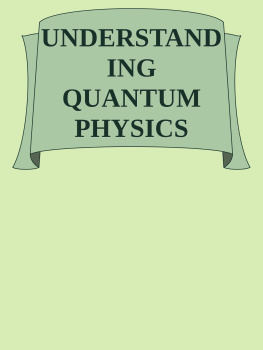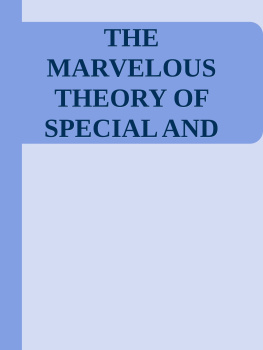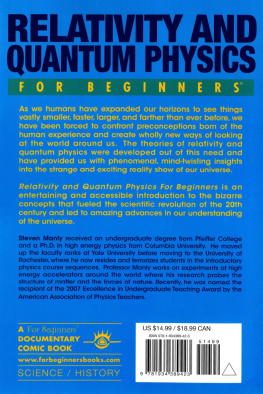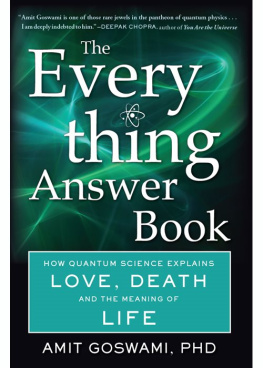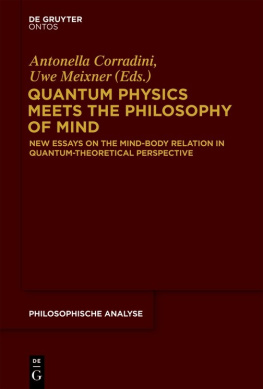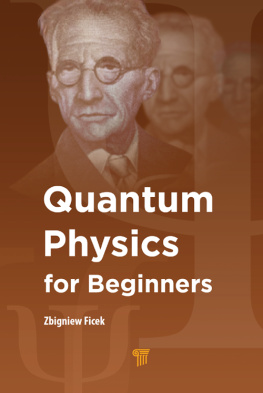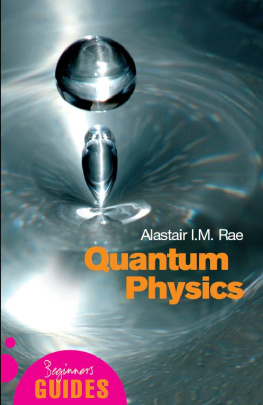Umberto Piacquadio - Understanding Quantum Physics
Here you can read online Umberto Piacquadio - Understanding Quantum Physics full text of the book (entire story) in english for free. Download pdf and epub, get meaning, cover and reviews about this ebook. year: 2019, genre: Science. Description of the work, (preface) as well as reviews are available. Best literature library LitArk.com created for fans of good reading and offers a wide selection of genres:
Romance novel
Science fiction
Adventure
Detective
Science
History
Home and family
Prose
Art
Politics
Computer
Non-fiction
Religion
Business
Children
Humor
Choose a favorite category and find really read worthwhile books. Enjoy immersion in the world of imagination, feel the emotions of the characters or learn something new for yourself, make an fascinating discovery.
- Book:Understanding Quantum Physics
- Author:
- Genre:
- Year:2019
- Rating:5 / 5
- Favourites:Add to favourites
- Your mark:
- 100
- 1
- 2
- 3
- 4
- 5
Understanding Quantum Physics: summary, description and annotation
We offer to read an annotation, description, summary or preface (depends on what the author of the book "Understanding Quantum Physics" wrote himself). If you haven't found the necessary information about the book — write in the comments, we will try to find it.
Understanding Quantum Physics — read online for free the complete book (whole text) full work
Below is the text of the book, divided by pages. System saving the place of the last page read, allows you to conveniently read the book "Understanding Quantum Physics" online for free, without having to search again every time where you left off. Put a bookmark, and you can go to the page where you finished reading at any time.
Font size:
Interval:
Bookmark:
UNDERSTANDING
QUANTUM PHYSICS
Written by Umberto Piacquadio (studio.gemix@gmail.com)Translated by Giulia Carcaterra
copyright Ed 2019 by Umberto Piacquadio
No part of this publication may be reproduced, stored in a retrieval system ortransmitted in any form or by any means, electronic, mechanical, photocopying,recording or otherwise without the prior permission of the author.
info
Not only is the Universe stranger than we think, it is strangerthan we can think
(Werner Heisenberg)
INDEX
1. ATOMIC HISTORY
2. THE ATOMIC MODELS 17
2.1 THOMPSON AND RUTHERFORD
2.2 ULTRAVIOLET CATASTROPHE
2.3 THE PLANCK CONSTANT 33
2.4 QUANTIZATION
2.5 BOHR ATOMIC MODEL
2.6 QUANTUM ATOMIC MODEL58
2.7 QUANTUM NUMBER OF SPIN
2.8 PRINCIPLE OF EXCLUSION OF PAULI
2.9 PRINCIPLE OF HEISENBERG INDETERMINATION
2.10 THE WAVE FUNCTION - SCHRDINGER EQUATION 90
2.11 SUPERPOSITION PRINCIPLE
2.12 SCHRDINGER'S CAT
2.13 WAVE- PARTICLE DUALITY
2.14 QUANTUM ENTANGLEMENT
2.15 OTHER INTERPRETATIONS AND THEORIES
3 THE ATOM
3.1 THE DIMENSIONS OF THE ATOM 138
3.2 THE NUCLEUS AND THE ISOTOPES
4. RADIOACTIVITY
4.1 NATURAL AND ARTIFICIAL RADIOACTIVITY 144
4.2 a DECAY 151
4.3 b- DECAY 152
4.4 b+ or b inverse DECAY
4.5 g DECAY 159
5 NUCLEAR FISSION
5.1 NUCLEAR CHAIN REACTION
5.2 UNCONTROLLED FISSION REACTION
5.3 CONTROLLED NUCLEAR FISSION 169
6 NUCLEAR FUSION
6.1 NUCLEAR FUSION REACTIONS
6.2 HYDROGEN BOMB (H BOMB )
6.3 NUCLEAR FUSION IN THE STARS 179
7 MATTER AND ANTIMATTER
7.1 THE ANTIMATTER 187
7.2 THE ELEMENTARY PARTICLES
7.3 THE GENERATION FERMIONS
7.4 THE SUCCESSIVE GENERATIONS OF THE FERMIONS
7.5 BOSONS 199
7.6 HIGGS BOSON
7.7 THE GRAVITON BOSON
8 PARTICLE ACCELERATORS
OTHER PUBLICATIONS 221
BIBLIOGRAPHY 223
After the formulations of Newton and Maxwell theories, it seemed thatnothing else could alter the path taken in the Physical description ofnatural phenomena.
The principle of causality well described the electromagneticphenomena and the motion of celestial bodies, from a deterministicpoint of view.
With the formulation of the Theory of relativity, Einstein continued thepath of description of the phenomena in motion even at speedscomparable to the one of light.
The change began with the in-depth and studies at the atomic levelwhere, Planck, Bohr and Einstein abandoned the concept of continuityin favor of the introduction of the matter's quantization, however,continuing to interpret the phenomena always with a classicalfoundation.
The contribution of the young Heinsenberg and Schoidenger will benecessary to definitively abandon the classical interpretation in order tointroduce the shocking interpretation of the new quantumThe subsequent formalization of quantum mechanics based on non-commutative algebra, introduced by the young Dirac continued the pathtowards the definitive use of quantum theory in the microscopic world.
With quantum physics we discover a whole new way of matter and lightbehaviour in the microcosm realm.
Grammatically it could be necessary to just invert one consonant for avocal : going from causality to casuality.
An atom is no longer made up of electrons orbiting like planets and it nolonger has a defined trajectory with certain values of speed and position.
Quantum physics describe the microcosm praising an evolution ofnature towards disorder and uncertainty, rather than a deterministicvision established by cause and effect, dominant in classical physics.
The particles can transmit instant information between themselves,beyond the limit of the speed of light, imposed by Einstein with theformulation of the special Relativity Theory.
Understanding the behavior of matter at the atomic level will lead you toimportant reflections, and to finally think that nothing that surrounds uscan be more interpreted with deterministic rationality alone.
To comprehend the fabolous world of quantum physics It is possible tofind hundreds of books, but most of the time they are either too popularor are treated at university level.
With the present exposition, instead, I tried to deal with these themesmaking you understand principally the concepts, without howeverneglecting the rigorous mathematical formulas and demonstrations,with a language that can be interpreted with mathematical and physicalskills that are learned in a high school.
The present text does not claim the prerogative of being exhaustive inthe interpretation of quantum theory, but it is certainly useful foracquiring notions in order to be able to understand from a scientific pointof view the texts on the market of a popular nature regarding this subjectand in any case creating excellent conditions for future in-depthuniversity studies.
I thank al those who have been close to me during the writing of thepresent discussion and with the hope of having set the work that couldbe useful to those who are approaching the study of the fascinatingworld of Quantum Physics. I am grateful since now to those who wantto propose improvements or possible suggestions.
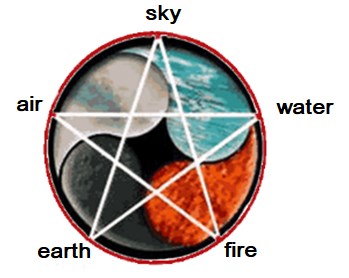
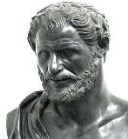
1. ATOMIC HISTORY
The constitution of matter history, from an atomic point of view, had begun as early as 1500 - 500 BC in India, where philosophical schools, in order to motivate the existence of matter, identified five fundamental essences of which it was composed: Fire - Earth - Air - Water - Sky.
In addition to the five substances they identified four additional external senses: Space, Time, Mind and final y the Ego.
Because of the introduction of these concepts, matter was always divisible into a finite number of particles, between the fundamental essences and the external senses.
Later, in ancient Greece, Leucippus of Miletus used the term Atomfor the first time (), which means indivisible, and his student Democritus of Abdera, in 460-360 BC, made it into a famous term.
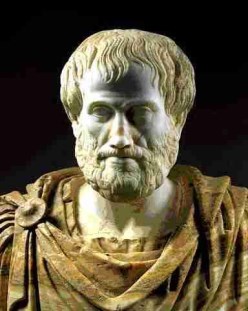
In this last interpretation, the atom was considered an indivisible particle of which matter was made up.
Everything else was fil ed with emptiness, like the same place where atoms bond together in a concept of eternity, through their birth, death and rebirth.
Therefore the concept of infinite divisibility, remained valid only in the logical-mathematical field, but it did not apply to the matter,because in a process of infinite divisibility it would have dissolved into nothingness, reaching an unworkable concept of non-matter.
Later, in 384-322 BC, Aristotle's theory,who stated that matter had to be understood as infinite and divisible was commonly accepted.So the concept of existence of the indivisible atom was abandoned.
Next pageFont size:
Interval:
Bookmark:
Similar books «Understanding Quantum Physics»
Look at similar books to Understanding Quantum Physics. We have selected literature similar in name and meaning in the hope of providing readers with more options to find new, interesting, not yet read works.
Discussion, reviews of the book Understanding Quantum Physics and just readers' own opinions. Leave your comments, write what you think about the work, its meaning or the main characters. Specify what exactly you liked and what you didn't like, and why you think so.

